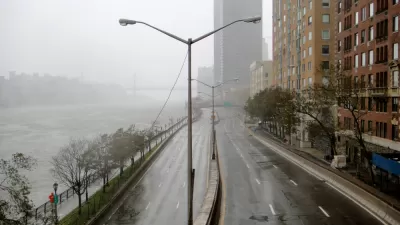Although power has been restored to much of Lower Manhattan, tenants of many of the area's residential and commercial buildings face a long and uncertain recovery before they can return. What will be the long-term effects on waterfront development?
With their lights back on and elevators operating, the easy part of repairing the many commercial and residential buildings in downtown Manhattan that suffered flood damage as a result of Superstorm Sandy is complete. However, according to N. R. Kleinfield, "the full extent of the damage to these buildings, which include major
office towers along Water, State and Front Streets, remains unclear.
Many owners are still furiously pumping out water, some of it
contaminated by toxins."
With "mechanical and
electrical systems destroyed by millions of gallons of water from
swollen rivers," and special cleanups required to clear contaminants, residents and office tenants like the International Planned Parenthood Federation, Morgan Stanley, The Daily News, and the Department of Homeless Services are learning that they may not be able to return to their homes and offices until Thanksgiving, or Christmas, or long after that.
With the potential adverse impacts of living and working near the city's waterfront now clear, Michelle Higgins looks at the prognosis for continued waterfront development. "Although real estate experts say property values are unlikely to suffer
in the long term, it is possible that new zoning and planning
regulations - and buyers' expectations - could reshape how residential
housing along the water is built, marketed and sold."
FULL STORY: Future Is in Limbo for the Damaged Buildings Close to the Water’s Edge

Study: Maui’s Plan to Convert Vacation Rentals to Long-Term Housing Could Cause Nearly $1 Billion Economic Loss
The plan would reduce visitor accommodation by 25,% resulting in 1,900 jobs lost.

North Texas Transit Leaders Tout Benefits of TOD for Growing Region
At a summit focused on transit-oriented development, policymakers discussed how North Texas’ expanded light rail system can serve as a tool for economic growth.

Using Old Oil and Gas Wells for Green Energy Storage
Penn State researchers have found that repurposing abandoned oil and gas wells for geothermal-assisted compressed-air energy storage can boost efficiency, reduce environmental risks, and support clean energy and job transitions.

Santa Barbara Could Build Housing on County Land
County supervisors moved forward a proposal to build workforce housing on two county-owned parcels.

San Mateo Formally Opposes Freeway Project
The city council will send a letter to Caltrans urging the agency to reconsider a plan to expand the 101 through the city of San Mateo.

A Bronx Community Fights to Have its Voice Heard
After organizing and giving input for decades, the community around the Kingsbridge Armory might actually see it redeveloped — and they want to continue to have a say in how it goes.
Urban Design for Planners 1: Software Tools
This six-course series explores essential urban design concepts using open source software and equips planners with the tools they need to participate fully in the urban design process.
Planning for Universal Design
Learn the tools for implementing Universal Design in planning regulations.
Ascent Environmental
Borough of Carlisle
Institute for Housing and Urban Development Studies (IHS)
City of Grandview
Harvard GSD Executive Education
Toledo-Lucas County Plan Commissions
Salt Lake City
NYU Wagner Graduate School of Public Service





























